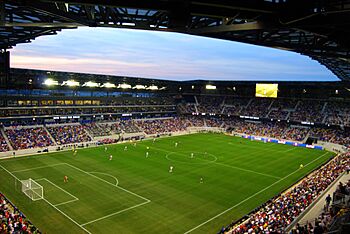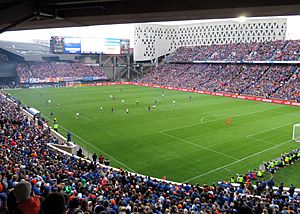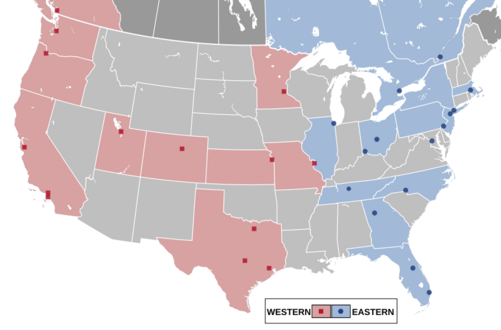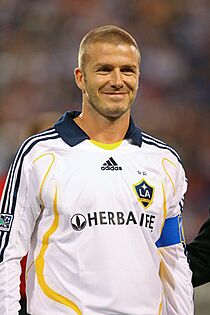Major League Soccer facts for kids
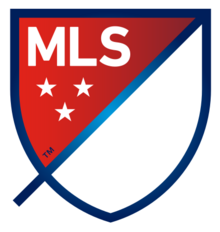 |
|
| Founded | December 17, 1993 |
|---|---|
| First season | 1996 |
| Confederation | CONCACAF |
| Conferences | Eastern Conference Western Conference |
| Number of teams | 30 |
| Level on pyramid | 1 |
| Domestic cup(s) | U.S. Open Cup Canadian Championship |
| International cup(s) | CONCACAF Champions Cup Campeones Cup Leagues Cup |
| Current MLS Cup | LA Galaxy (6th title) (2024) |
| Current Supporters' Shield | Inter Miami CF (1st shield) (2024) |
| Most MLS Cups | LA Galaxy (6 titles) |
| Most Supporters' Shields | D.C. United LA Galaxy (4 shields each) |
| Most appearances | Nick Rimando (514) |
| Top goalscorer | Chris Wondolowski (171) |
| TV partners | MLS Season Pass (Apple TV)
|
Major League Soccer (MLS) is a top professional soccer league in North America. It's the highest level of soccer in the United States soccer league system. The league has 30 teams, with 27 in the United States and 3 in Canada. MLS is one of the biggest professional sports leagues in the U.S. and Canada. Its main office is in Midtown Manhattan, New York City.
MLS was started in 1993. This happened because the United States promised to create a top soccer league to host the 1994 FIFA World Cup. The first season was in 1996 with ten teams. In its early years, MLS faced some challenges and even lost money. But things changed! The league built many soccer-specific stadiums, which are stadiums made just for soccer. They also created the Designated Player Rule. This rule allowed teams to sign famous star players like David Beckham and Lionel Messi. These changes helped MLS become very popular and successful.
By 2022, MLS games had an average of over 21,000 fans per game. This made it the fourth most attended major sports league in the U.S. and Canada. Only the National Football League (NFL), Major League Baseball (MLB), and Canadian Football League (CFL) had more fans. In 2024, MLS was the second most attended soccer league in the world overall, right after the Premier League.
The MLS regular season usually runs from late February or early March to mid-October. Each team plays 34 games. The team with the best record wins the Supporters' Shield. After the regular season, 18 teams compete in the MLS Cup playoffs in October and November. This tournament ends with the MLS Cup, which is the league's championship game. MLS is different from most soccer leagues around the world because it doesn't use a system where teams move up or down divisions (called promotion and relegation). Instead, it has a fixed number of teams, like other major sports leagues in the U.S. and Canada.
The LA Galaxy has won the most MLS Cups, with six titles. They are tied with D.C. United for the most Supporters' Shields, with four each.
Contents
History of MLS
MLS is the newest top professional soccer league in the United States and Canada. Before MLS, there was the North American Soccer League (NASL) from 1968 to 1984. The NASL became very popular in the mid-1970s when teams like the New York Cosmos signed global stars such as Pelé and Franz Beckenbauer. Other famous players like Johan Cruyff also joined. Even with huge crowds, the NASL eventually closed down after the 1984 season. This left the U.S. without a top soccer league until MLS began.
How MLS Started
In 1988, the U.S. Soccer promised to create a top professional soccer league. This promise helped the U.S. get the right to host the 1994 FIFA World Cup. In 1993, Major League Professional Soccer (which became MLS) was chosen as the official Division 1 league. Major League Soccer officially started in February 1995.
Tab Ramos was the very first player signed by MLS on January 3, 1995. He joined the New York/New Jersey MetroStars. MLS began playing in 1996 with ten teams. The first game was on April 6, 1996, where the San Jose Clash beat D.C. United. Famous players from the 1994 World Cup, like U.S. stars Alexi Lalas and Tony Meola, and foreign players like Mexico's Jorge Campos, joined the league.
D.C. United was very strong early on, winning the MLS Cup three times in the league's first four seasons. In 1998, MLS added its first two new teams: the Miami Fusion and the Chicago Fire. The Chicago Fire even won the championship in their first year!
In its early years, MLS tried some different rules to make soccer more "American." They used shootouts to decide tied games and a countdown clock. However, these changes didn't attract new fans and actually bothered some traditional soccer fans. So, the league removed the shootout and countdown clock after the 1999 season.
The league faced financial problems, losing a lot of money in its first few years. In 1999, Don Garber, a former NFL executive, became the new commissioner. To help the league, two teams, the Tampa Bay Mutiny and Miami Fusion, were closed down in 2002, leaving MLS with ten teams.
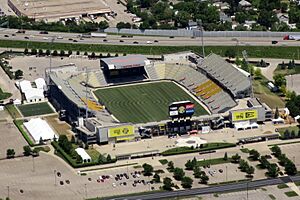
Even with these challenges, MLS had important achievements. In 1999, Historic Crew Stadium was built for the Columbus Crew. This was the first stadium made specifically for soccer in MLS. This started a trend for teams to build their own stadiums instead of renting large American football stadiums. Owning their stadiums helped teams earn more money from events and concessions.
MLS Becomes Stronger
The 2002 FIFA World Cup, where the U.S. team reached the quarterfinals, helped soccer become more popular in America and boosted MLS. The MLS Cup 2002 final had over 61,000 fans, showing growing interest.
MLS also focused on building more soccer-specific stadiums. Between 2003 and 2008, six more of these stadiums were built. By the end of 2008, most MLS teams played in stadiums designed just for soccer. This was a big step for the league's financial health.
During this time, MLS also started adding new teams again. Real Salt Lake and Chivas USA joined in 2005. In 2006, the San Jose Earthquakes team moved to Texas and became the Houston Dynamo. Later, a new San Jose team was formed in 2007.
Star Players Join MLS
In 2007, MLS expanded into Canada with the Toronto FC team. To make the league even better, MLS created the Designated Player Rule. This rule allowed teams to sign international soccer stars.
The 2007 season saw the famous David Beckham join MLS. His arrival was a huge moment for American soccer, made possible by the Designated Player Rule. Other important Designated Players like Cuauhtémoc Blanco and Juan Pablo Ángel also made a big impact.
More teams joined the league. In 2009, Seattle Sounders FC started playing and set a new attendance record for the league. In 2010, the Philadelphia Union joined and opened their new stadium. The New York Red Bulls also opened their new soccer-specific stadium, Red Bull Arena, and French star Thierry Henry joined the team.
The league continued to grow in 2011 with the addition of Vancouver Whitecaps FC and the Portland Timbers. By 2011, MLS had an average attendance of over 17,800 fans per game, which was higher than the NBA and NHL. In 2012, the Montreal Impact became the 19th team and the third Canadian team in MLS.
Growing the League
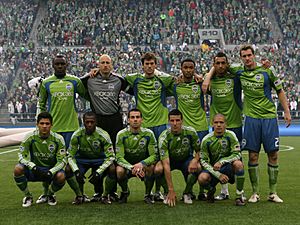
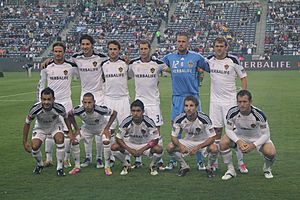
By 2012, MLS had the third-highest average attendance among U.S. sports leagues, after the NFL and MLB. It was also the seventh most attended professional soccer league worldwide.
In 2013, MLS announced that New York City FC and Orlando City Soccer Club would join the league in 2015. The league also started a "Core Players" plan to help teams keep their best players from leaving for foreign leagues.
Before the 2014 World Cup, MLS began signing U.S. stars who were playing abroad, like Clint Dempsey and Michael Bradley. By 2014, many MLS head coaches had also played in the league. MLS became as popular as Major League Baseball among 12- to 17-year-olds by 2013.
In 2014, MLS announced Atlanta United FC would join in 2017. New York City FC and Orlando City SC signed famous players like David Villa and Kaká even before their first season in 2015. The 2014 World Cup featured 21 MLS players on national team rosters.
MLS changed its logo in 2014. The new logo is a simple crest with a diagonal stripe and three stars. These stars represent "community, club, and country." Each team uses the new logo in its own colors on its jerseys.
Chivas USA closed down after the 2014 season. New York City FC and Orlando City SC joined in 2015 as the 19th and 20th teams.
In 2015, many more international stars joined MLS, including Steven Gerrard and Didier Drogba. In 2016, MLS confirmed that Minnesota United FC would start playing in 2017, along with Atlanta United FC.
The league continued to expand. In 2017, MLS received bids from 12 groups wanting to add new teams. In October 2017, the owner of Columbus Crew announced plans to move the team to Austin, Texas. This caused a lot of discussion and legal action. Eventually, a deal was made for a new ownership group to buy the Columbus Crew and keep them in Columbus. Austin then received a new expansion team, Austin FC, which joined in 2021.
MLS announced new expansion teams for Nashville, Tennessee (Nashville SC, joined 2020) and Miami (Inter Miami CF, led by David Beckham, joined 2020). Cincinnati, Ohio also got an expansion team, FC Cincinnati, which started playing in 2019.
The league planned to expand to 30 teams. Charlotte FC joined in 2022. In 2020, the MLS season was paused because of the COVID-19 pandemic. The season restarted with the MLS is Back Tournament in Orlando. In September 2020, MLS announced MLS Next, a new league for youth academy teams.
In 2022, MLS signed a big 10-year deal with Apple Inc.. This made Apple TV the main place to watch all MLS games starting in 2023. This deal changed the game schedule, with most matches now starting at 7:30 p.m. local time on Wednesdays and Saturdays.
In May 2023, MLS announced that San Diego FC would join as the 30th team for the 2025 season. The 2024 season broke attendance records, with an average of 23,240 fans per match. The arrival of Lionel Messi and other star players helped bring in these record crowds.
Expansion Fees
Joining MLS costs a lot of money. In 2005, Toronto FC's owners paid $10 million to join. By 2007, the fee for Seattle Sounders FC was $30 million. In 2013, New York City FC paid a record $100 million. This record was broken again by FC Cincinnati and Nashville SC, who each paid $150 million. In 2019, Charlotte FC agreed to a reported $325 million fee. The newest team, San Diego FC, paid a record $500 million in 2023.
How MLS Competitions Work
The MLS regular season runs from late February or early March to October. Teams are divided into two groups: the Eastern and Western Conferences. Each team plays 34 games. With 30 teams in 2025, each team plays two games (home and away) against other teams in their own conference. They also play six games against teams from the other conference. The team with the most points at the end of the regular season wins the Supporters' Shield. This team also gets home-field advantage throughout the playoffs.
Midway through the season, teams take a break for the All-Star Game. This is a special game featuring the league's best players. Since 2015, the last day of the regular season is called "Decision Day." On this day, almost all games are played at the same time within each conference.
Unlike most soccer leagues worldwide, MLS has a playoff tournament after the regular season to decide the league champion. As of 2023, 18 teams compete in the MLS Cup Playoffs in October and November. The playoffs end with the MLS Cup championship game in early December. The 2023 playoff format includes single-elimination play-in matches for the lowest-ranked teams. Then, there's a best-of-three round, followed by more single-elimination rounds leading to the MLS Cup final.
The MLS schedule runs from spring to fall. This can sometimes conflict with international tournaments like the World Cup and Gold Cup. This means some players might miss league games. MLS has thought about changing to a fall-to-spring schedule, like many European leagues. However, this would mean competing with popular U.S. sports like the NFL, NBA, and NHL during their main seasons.
Other Soccer Competitions
MLS teams also play in other competitions, both international and domestic. Each season, up to ten MLS teams play in the CONCACAF Champions Cup (CCC). This tournament features clubs from the CONCACAF region (North, Central America, and the Caribbean). Teams qualify for the CCC based on their previous year's regular-season results, winning the MLS Cup, or winning other cups.
U.S.-based MLS teams also compete in the U.S. Open Cup. Starting in 2024, the league sends eight teams to this tournament, along with some MLS Next Pro teams. Canadian MLS teams like Montreal, Toronto, and Vancouver play in the Canadian Championship. The winner of this tournament earns a spot in the CONCACAF Champions Cup.
Since 2018, the reigning MLS Cup champion plays in the Campeones Cup. This is a single game against the champion from Mexico's Liga MX. The MLS team hosts this game in September.
Another competition with Liga MX is the Leagues Cup, which started in 2019. Beginning in 2023, all MLS and Liga MX teams participate in this tournament. It acts as the regional cup for the North American zone of CONCACAF.
Seattle Sounders FC made history in 2022 by becoming the first MLS team to win the CONCACAF Champions Cup under its new format.
MLS Clubs
The league has 30 clubs, split between the Eastern and Western conferences. MLS has grown steadily since 2005, with the newest team, San Diego FC, joining in 2025.
MLS has many rivalry cups where two or more teams compete. These often involve teams from the same area. The trophy goes to the team with the best record in games against the other participating teams during the regular season.
Traveling long distances is common in MLS. For example, the teams furthest apart are Vancouver Whitecaps FC and Inter Miami CF, which are over 2,800 miles (4,500 km) apart. In the 2018 season, the team that traveled the shortest distance was Toronto FC, while Vancouver traveled the longest.
| Conference | Club | Location | Stadium | Capacity | Joined | Head coach |
|---|---|---|---|---|---|---|
| Eastern | Atlanta United FC | Atlanta, Georgia | Mercedes-Benz Stadium | 42,500 | 2017 | Ronny Deila |
| Charlotte FC | Charlotte, North Carolina | Bank of America Stadium | 38,000 | 2022 | Dean Smith | |
| Chicago Fire FC | Chicago, Illinois | Soldier Field | 24,995 | 1998 | Gregg Berhalter | |
| FC Cincinnati | Cincinnati, Ohio | TQL Stadium | 26,000 | 2019 | Pat Noonan | |
| Columbus Crew | Columbus, Ohio | Lower.com Field | 20,000 | 1996 | Wilfried Nancy | |
| D.C. United | Washington, D.C. | Audi Field | 20,000 | 1996 | Troy Lesesne | |
| Inter Miami CF | Fort Lauderdale, Florida | Chase Stadium | 21,550 | 2020 | Javier Mascherano | |
| CF Montréal | Montreal, Quebec | Saputo Stadium | 19,619 | 2012 | Marco Donadel (interim) | |
| Nashville SC | Nashville, Tennessee | Geodis Park | 30,000 | 2020 | B.J. Callaghan | |
| New England Revolution | Foxborough, Massachusetts | Gillette Stadium | 20,000 | 1996 | Caleb Porter | |
| New York City FC | The Bronx, New York | Yankee Stadium | 30,321 | 2015 | Pascal Jansen | |
| New York Red Bulls | Harrison, New Jersey | Sports Illustrated Stadium | 25,000 | 1996 | Sandro Schwarz | |
| Orlando City SC | Orlando, Florida | Inter&Co Stadium | 25,500 | 2015 | Óscar Pareja | |
| Philadelphia Union | Chester, Pennsylvania | Subaru Park | 18,500 | 2010 | Bradley Carnell | |
| Toronto FC | Toronto, Ontario | BMO Field | 28,351 | 2007 | Robin Fraser | |
| Western | Austin FC | Austin, Texas | Q2 Stadium | 20,500 | 2021 | Nico Estévez |
| Colorado Rapids | Commerce City, Colorado | Dick's Sporting Goods Park | 18,061 | 1996 | Chris Armas | |
| FC Dallas | Frisco, Texas | Toyota Stadium | 19,096 | 1996 | Eric Quill | |
| Houston Dynamo FC | Houston, Texas | Shell Energy Stadium | 22,039 | 2006 | Ben Olsen | |
| LA Galaxy | Carson, California | Dignity Health Sports Park | 27,000 | 1996 | Greg Vanney | |
| Los Angeles FC | Los Angeles, California | BMO Stadium | 22,000 | 2018 | Steve Cherundolo | |
| Minnesota United FC | Saint Paul, Minnesota | Allianz Field | 19,400 | 2017 | Eric Ramsay | |
| Portland Timbers | Portland, Oregon | Providence Park | 25,218 | 2011 | Phil Neville | |
| Real Salt Lake | Sandy, Utah | America First Field | 20,213 | 2005 | Pablo Mastroeni | |
| San Diego FC | San Diego, California | Snapdragon Stadium | 35,000 | 2025 | Mikey Varas | |
| San Jose Earthquakes | San Jose, California | PayPal Park | 18,000 | 1996 | Bruce Arena | |
| Seattle Sounders FC | Seattle, Washington | Lumen Field | 37,722 | 2009 | Brian Schmetzer | |
| Sporting Kansas City | Kansas City, Kansas | Children's Mercy Park | 18,467 | 1996 | Kerry Zavagnin (interim) | |
| St. Louis City SC | St. Louis, Missouri | Energizer Park | 22,423 | 2023 | David Critchley (interim) | |
| Vancouver Whitecaps FC | Vancouver, British Columbia | BC Place | 22,120 | 2011 | Jesper Sørensen |
Former Clubs
| Club | Location | Stadium | Capacity | Joined | Final season |
|---|---|---|---|---|---|
| Tampa Bay Mutiny | Tampa, Florida | Raymond James Stadium | 65,657 | 1996 | 2001 |
| Miami Fusion | Fort Lauderdale, Florida | Lockhart Stadium | 17,417 | 1998 | 2001 |
| Chivas USA | Carson, California | StubHub Center | 18,800 | 2005 | 2014 |
Timeline of MLS Teams
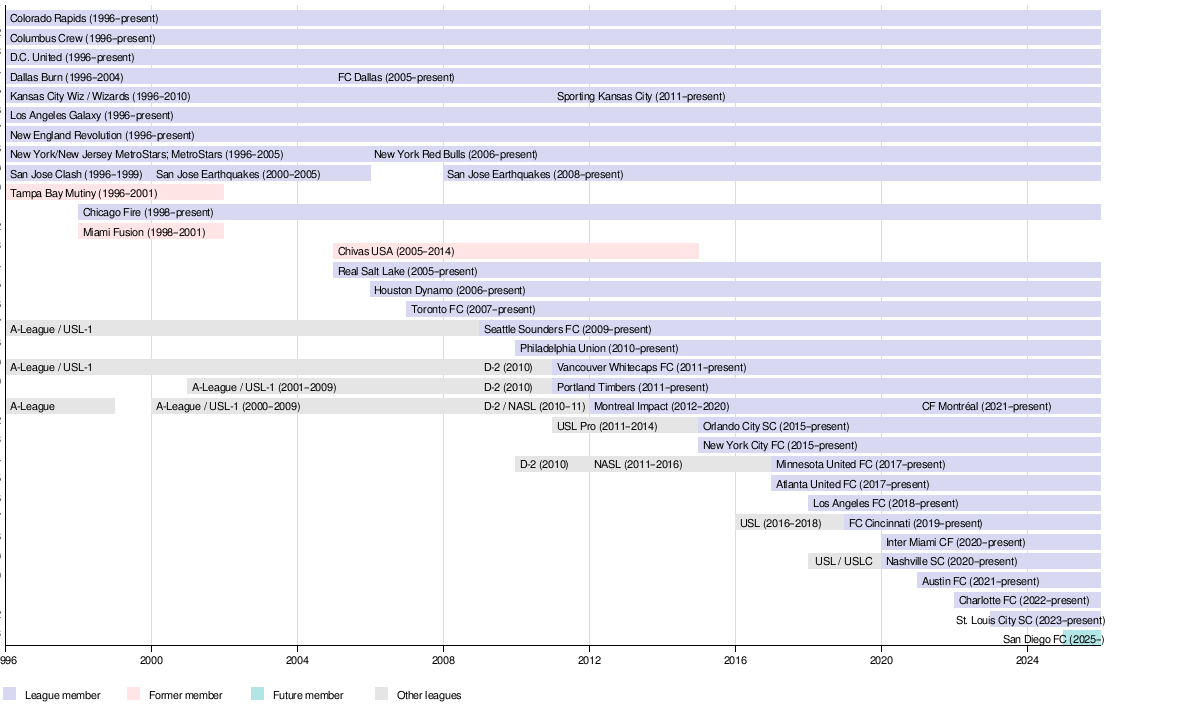
League Championships
As of the 2024 season, 32 different clubs have played in MLS. 15 of them have won at least one MLS Cup, and 16 have won at least one Supporters' Shield. Eight times, a club has won both trophies in the same year. Only one team, Toronto FC, has also won its national domestic cup (the Canadian Championship) in the same year, achieving a domestic treble.
| Team | MLS Cups |
Years won | Supporters' Shields |
Years won | Total combined |
MLS seasons |
|---|---|---|---|---|---|---|
| LA Galaxy | 6 | 2002, 2005, 2011, 2012, 2014, 2024 | 4 | 1998, 2002, 2010, 2011 | 10 | 29 |
| D.C. United | 4 | 1996, 1997, 1999, 2004 | 4 | 1997, 1999, 2006, 2007 | 8 | 29 |
| Columbus Crew | 3 | 2008, 2020, 2023 | 3 | 2004, 2008, 2009 | 6 | 29 |
| San Jose Earthquakes | 2 | 2001, 2003 | 2 | 2005, 2012 | 4 | 27 |
| Sporting Kansas City | 2 | 2000, 2013 | 1 | 2000 | 3 | 29 |
| Seattle Sounders FC | 2 | 2016, 2019 | 1 | 2014 | 3 | 16 |
| Houston Dynamo FC | 2 | 2006, 2007 | 0 | – | 2 | 19 |
| Los Angeles FC | 1 | 2022 | 2 | 2019, 2022 | 3 | 7 |
| Chicago Fire FC | 1 | 1998 | 1 | 2003 | 2 | 27 |
| Toronto FC | 1 | 2017 | 1 | 2017 | 2 | 18 |
| Real Salt Lake | 1 | 2009 | 0 | – | 1 | 20 |
| Colorado Rapids | 1 | 2010 | 0 | – | 1 | 29 |
| Portland Timbers | 1 | 2015 | 0 | – | 1 | 14 |
| Atlanta United FC | 1 | 2018 | 0 | – | 1 | 8 |
| New York City FC | 1 | 2021 | 0 | – | 1 | 10 |
| New York Red Bulls | 0 | – | 3 | 2013, 2015, 2018 | 3 | 29 |
| Tampa Bay Mutiny | 0 | – | 1 | 1996 | 1 | 6 |
| Miami Fusion | 0 | – | 1 | 2001 | 1 | 4 |
| FC Dallas | 0 | – | 1 | 2016 | 1 | 29 |
| Philadelphia Union | 0 | – | 1 | 2020 | 1 | 15 |
| New England Revolution | 0 | – | 1 | 2021 | 1 | 29 |
| FC Cincinnati | 0 | – | 1 | 2023 | 1 | 6 |
| Inter Miami CF | 0 | – | 1 | 2024 | 1 | 5 |
How MLS is Organized
Team Ownership
MLS works like a single company where the league owns all the teams and player contracts. Each team has an investor-operator who is a part-owner of the league. This setup helps control costs and keeps teams competitive. In a lawsuit in 2002, a court decided that MLS's way of managing player contracts and salaries was legal.
In the early years, some investors owned multiple teams. For example, one company owned six MLS teams at one point. To attract more investors, MLS changed its rules in 2002. These changes gave team operators more control over their team's money and allowed them to sell jersey sponsorships.
As MLS grew, it wanted each team to have its own owner. New investors brought more money into the league. For example, Red Bull bought the MetroStars team in 2006 for over $100 million. By 2015, all 30 MLS clubs had their own separate investor-operators.
League Leadership
Don Garber has been the commissioner of Major League Soccer since 1999. He is the league's chief executive. The first commissioner was Doug Logan, who served from 1995 to 1999.
Player Salaries and Rules
In 2016, the average salary for MLS players was about $373,094. This was lower than some other leagues around the world. The league's minimum salary for most players increased to $65,000 in 2017.
MLS uses a salary cap. This limits how much teams can spend on player salaries. The salary cap helps prevent teams from spending too much and keeps the league competitive. In 2017, the salary cap was $3.845 million per team. Each team can have up to 30 players on its main roster.
Teams can sign players from other leagues. MLS has two "transfer windows" each year. These are periods when teams can buy and sell players. When an MLS club sells a player to a team overseas, the club and the league share the money from the sale.
MLS teams have a limited number of spots for international players (non-U.S. or Canadian players). However, teams often help international players get green cards. This makes them count as domestic players and frees up international spots. In 2015, almost half of MLS players were from outside the U.S. and Canada.
Designated Players and Extra Money
MLS has special rules to help teams sign better players while still having a salary cap. The Designated Player (DP) rule allows teams to sign a few players whose salaries are higher than the normal cap. In 2017, each DP player only counted as $480,625 against the cap. This rule started in 2007, and David Beckham was the first player signed under it.
Teams can also get "allocation money." This is extra money that teams can use for player salaries that doesn't count against the cap. Teams can earn allocation money in different ways, like from selling players to other leagues. MLS also has "Targeted Allocation Money" (TAM). Teams use TAM to sign high-profile players or to reduce the salary cap impact of certain players. Famous players like Zlatan Ibrahimović and Giorgio Chiellini have been signed using TAM.
Developing Young Players
MLS has programs to help develop young soccer players. Rules about "Generation Adidas" players and "homegrown" players encourage clubs to find and keep young talent.
Since 2008, all MLS teams must have youth development programs (academies). Teams can sign players directly from their own academies without going through the draft. There's also special money for homegrown players who join the senior team. A great example of a successful homegrown player is Jozy Altidore. He became famous in MLS as a teenager before moving to a team in Spain.
The league also runs the Generation Adidas program with U.S. Soccer. This program helps young American players join MLS. Famous players like Landon Donovan and Clint Dempsey came through this program. Players on Generation Adidas contracts don't count against the team's salary cap.
MLS also has a reserve league called MLS Next Pro. This league gives playing time to players who aren't starting for their main MLS teams. In 2022, most MLS clubs had a reserve team in MLS Next Pro.
Stadiums for Soccer
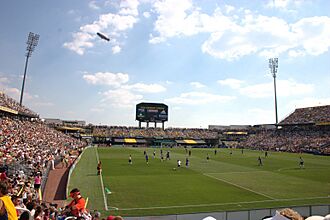
Since 1999, MLS has helped build many stadiums specifically for soccer. These "soccer-specific stadiums" make the game day experience better for fans. They also help teams financially because they don't have to pay rent and can earn money from concessions, parking, and other events. Many teams have seen their season ticket sales double after moving into a soccer-specific stadium. Building these stadiums is seen as a key reason for the league's success.
The Columbus Crew started this trend in 1999 by building Historic Crew Stadium. The LA Galaxy followed in 2003 with Dignity Health Sports Park. Many other teams have built their own soccer stadiums since then, including FC Dallas, Chicago Fire FC, Colorado Rapids, Toronto FC, Real Salt Lake, New York Red Bulls, Philadelphia Union, Portland Timbers, Sporting Kansas City, Houston Dynamo FC, CF Montréal, San Jose Earthquakes, Orlando City SC, D.C. United, Minnesota United FC, Los Angeles FC, FC Cincinnati, Nashville SC, Austin FC, and St. Louis City SC.
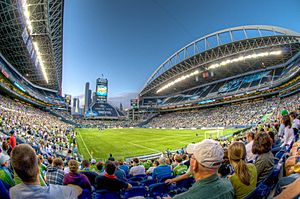
Some teams still play in stadiums not originally built for soccer. For example, New York City FC plays at Yankee Stadium, a baseball venue, but plans to build its own soccer stadium. The New England Revolution plays at Gillette Stadium, an NFL stadium. The Seattle Sounders FC play at Lumen Field, which is used for both American football and soccer. The Vancouver Whitecaps FC play at BC Place, a stadium used for Canadian football and soccer.
Media Coverage
MLS Season Pass on Apple TV
Since 2023, all MLS and Leagues Cup matches are available worldwide on MLS Season Pass through Apple TV. This means fans can watch every game in one place. This agreement also allows some games to be shown on regular TV channels. In the U.S., Fox Sports broadcasts some MLS games. In Canada, TSN and RDS show games.
United States TV Coverage
From 2015 to 2022, MLS games were shown nationally by ESPN and Fox Sports in English, and Univision in Spanish. These networks shared coverage of the playoffs, and ABC and Fox took turns broadcasting the MLS Cup final.
Before the Apple TV deal, games not shown nationally were broadcast regionally by local sports networks. These regional games were available to watch online through ESPN+.
Canadian TV Coverage
In Canada, TSN networks hold the English-language rights to MLS games. They mainly show matches involving Canadian teams. TVA Sports has the French-language rights to MLS in Canada.
International TV Coverage
MLS games are also broadcast in other countries. For example, from 2015 to 2019, Sky Sports showed two MLS matches per week in the United Kingdom and Ireland. SBS Sport Australia started broadcasting one MLS game per week in Australia in 2025.
Video Games
Major League Soccer is a playable league in popular video game series like EA Sports FC and eFootball. The league first appeared in a video game in 1999 with FIFA 2000.
Player Records
These statistics show the all-time leaders in MLS regular season games. Bold names mean the player is still active in MLS.
|
|
|
|
Active Player Records
These statistics show the all-time leaders who are still playing in MLS. Statistics are for regular season only.
|
|
|
|
MLS Awards
At the end of each season, MLS gives out several awards. These awards recognize great achievements by players, coaches, referees, and teams. The winners are chosen by votes from MLS players, team staff, and the media.
- MLS Best XI
- Sigi Schmid Coach of the Year Award
- MLS Comeback Player of the Year Award
- MLS Defender of the Year Award
- MLS Fair Play Award (individual)
- MLS Fair Play Award (team)
- MLS Goal of the Year Award
- MLS Goalkeeper of the Year Award
- MLS Golden Boot
- MLS Humanitarian of the Year Award
- Landon Donovan MVP Award
- MLS Newcomer of the Year Award
- MLS Referee of the Year Award
- MLS Young Player of the Year Award
- MLS Save of the Year Award
See also
 In Spanish: Major League Soccer para niños
In Spanish: Major League Soccer para niños
- MLS SuperDraft
- List of Major League Soccer seasons
- List of American and Canadian soccer champions
- List of Major League Soccer stadiums
- Major League Soccer attendance
- MLS Players Association
- United States soccer league system


